Composition of breast forms
Breast augmentation by prosthesis relies on sophisticated medical devices; in this article, we explain the composition of a breast implant and the specific features that ensure its quality and durability.
The composition of breast implants
Un implant mammaire en silicone (ou prothèse mammaire) est un dispositif médical de classe III c’est-à-dire destiné à l’implantation définitive dans le corps humain. Il doit obtenir un marquage CE et pour être utilisé en France, doit être inscrit sur le registre LPPR de l’agence nationale de sécurité du médicament et des produits de santé (ANSM). Il doit faire l’objet d’une traçabilité et d’une matériovigilance.
Le principe d’une prothèse mammaire est le même quel que soit le type d’implant. Il est composé d’une enveloppe de 3 couches de silicone médicale, dont les caractéristiques peuvent varier, remplie de gel de silicone, d’eau ou d’Hydrogel.
The different types of breast implants
Breast implants are classified according to their filler, the characteristics of their shell and their shape.
Les différents types de produits de remplissage
Prothèses mammaires remplies de sérum physiologique
Les implants mammaires en sérum physiologique sont extrêmement sûres qui ont été utilisées exclusivement en France de 1997 à 2001. Aujourd’hui, elles représentent moins de 5 % des poses en France. Leur forme est forcément ronde, et leur enveloppe obligatoirement lisse. Le sérum physiologique est injecté par une valve de remplissage pendant l’intervention. Ceci permet d’insérer la prothèse mammaire vide par une cicatrice de moins de 2 cm. Ses avantages principaux sont l’innocuité de son produit de remplissage et le fait que tout usure de la prothèse va immédiatement être diagnostiquée (apparition de plis ou dégonflage total de l’implant). Cependant, elles présentent certains inconvénients :
- impossibility of having an anatomical shape
- slightly less natural feel than silicone gel
- possibility of abrupt deflation, possibly on vacation, with no possibility of changing the implant
- shorter average lifespan due to implant fragility at the filling valve
Silicone gel-filled breast forms
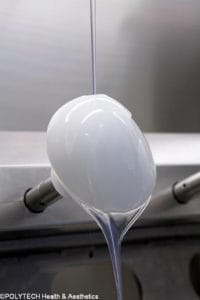
These are the most widely used breast implants in the world. Their shell is made up of 3 layers of silicone elastomer. To achieve this, a mold of a specific shape is dipped several times in specific silicones.
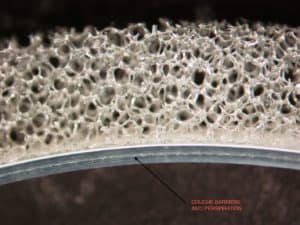
An anti-perspiration barrier layer is inserted between the 2 outer and inner layers.
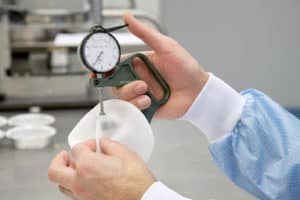
Once the envelope has been manufactured, a number of checks are carried out, in particular to ensure that the thickness of the envelope is uniform.
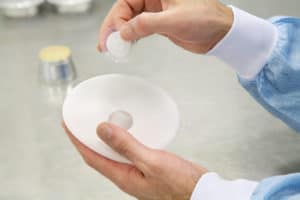
The hole left by the mold mandrel is occluded by a patch.
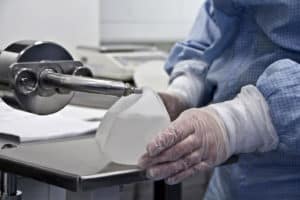
The silicone gel is then injected into the envelope in liquid form.
Le silicone médical injecté est fourni par un des 2 fabricants de gel validés par la FDA américaine Nusil ou Applied Silicon. En fin de remplissage, un catalyseur est ajouté. Puis l’implant mammaire est chauffé pour permettre une polymérisation du gel. Nous avons une nette préférence pour le gel responsif proposé par Applied Silicon. Celui-ci permet un effet à mémoire de forme et évite les plis dans le haut de la prothèse. Il possède aussi une résistance à l’étirement très élevé qui évite toute fracture du gel lors de l’insertion de l’implant.
It is a gel, not liquid silicone, that fills the prosthesis. If there is a rupture in the envelope, the gel will not spread into the body and will remain cohesive.
Cette conception complexe et pointue explique les avantages et les inconvénients des implants mammaires pré-remplis de gel de silicone. Concernant les avantages on retient :
- the ability to use anatomical shapes
- un toucher plus naturel avec moins de plis
- longer service life than serum-filled implants thanks to the absence of a filling valve
The disadvantages include
- la nécessité de réaliser une cicatrice plus longue (entre 3 et 5 cm selon le volume de l’implant)
- more difficult to monitor the integrity of the implant membrane: the implant does not deflate, and a rupture may go unnoticed on clinical examination.
- the possibility of silicone migration in the event of unnoticed rupture
Nous réalisons plus de 95 % de nos cas d’implants mammaires avec des prothèses pré-remplies de gel de silicone. Leur durée de vie moyenne est plus longue, cependant nous recommandons un examen clinique et une échographie annuelle ainsi qu’ une IRM tous les 2 ans à partir de la 5ème année post-opératoire afin de dépister des ruptures asymptomatiques.
The different types of breast implant envelope texturing
The breast implant shell is the interface between the implant and your body. Depending on the type of envelope, your body will react differently to the implant. This is a key factor in the development of capsular contracture.
There are two types of hulls:
- early shells (within 6 months of surgery). They are linked to the proliferation of bacteria colonizing the skin and/or mammary gland around the prosthesis (known as Biofilm). These bacteria proliferate if they have entered in large quantities, there is an accumulation of blood around the prosthesis, and the inflammatory reaction around the implant is weak.
- les coques tardives (entre 5 et 25 ans après l’intervention) qui sont liées à une usure de l’enveloppe de silicone et/ou à une rupture de l’implant. Le silicone dégradé va provoquer une inflammation locale, durcir le sein et aboutir à une coque.
With smooth envelopes
Smooth breast forms were the first to be marketed. Saline-filled implants are only available with this type of envelope. Smooth breast implants are only available in round shapes. Their advantages include:
- the possibility of inserting them through a small incision
- a thin envelope that's hard to feel
- very little post-operative reaction around the implant
Leur inconvénient principal est expliqué par ce dernier point. Comme la réaction inflammatoire post opératoire est très limitée, les globules blancs n’éliminent pas le biofilm autour de la prothèse et ceci aboutit à un taux de coque précoce de pratiquement 10%. Ceci est particulièrement fréquent en cas de cicatrice autour de l’aréole qui nécessite de couper la glande mammaire en deux et libère le biofilm des canaux galactophores (amenant le lait au mamelon) de la glande mammaire. Afin de prévenir au mieux cette complication, nous préconisons la voie d’abord sous-mammaire et proposant systématiquement un traitement médicamenteux post opératoire permettant de réduire le risque de coque..
With micro or macro-textured envelopes.
Ces enveloppes ont été développées dans les années 80 pour réduire le taux de coques. La texturation va provoquer une réaction inflammatoire post opératoire et va désorganiser les fibres de collagène. Leur avantage principal est donc la réduction du taux de coques de 10% avec les implants lisses à environ 3% avec les implants texturés.
Néanmoins, cette texturation a été reconnue responsable de cas de lymphome anaplasique à grandes cellules.
De fait, nous n’utilisons plus ce type d’implant et nous recommandons fortement le choix d’implants lisses.
The different shapes of breast implants
The rounds
Ces implants mammaires sont les plus utilisés dans le monde. Leur avantage principal réside dans le fait que leur forme ne change pas, même en cas de rotation de l’implant. Cependant, des implants ronds de haut profil avec une base plate peuvent se retourner dans le sens antéro-postérieur. Les implants ronds donnent généralement beaucoup de projection dans la partie supérieure du sein ce qui favorise le décolleté. L’aspect général du sein augmenté prend alors une forme de pomme que certaines patientes ne trouvent pas assez « naturel ».
Un des problèmes de ces implants est la visibilité éventuelle de leur bord supérieur en cas de pose de la prothèse devant le muscle rendant ainsi nécessaire une pose derrière le muscle plus douloureuse si le volume choisi est supérieur à 300 cc. Nous utilisons ce type d’implant dans 20 % de nos cas, notamment si la patiente a déjà une poitrine bien formée et si elle souhaite obtenir un décolleté plus généreux.
Read our article to find out more about the price of breast augmentation by prosthesis.
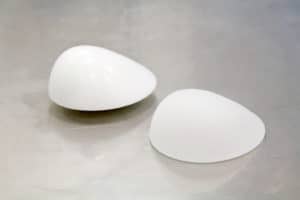
Breast implants have an envelope that is defined by specific molds. It defines the general shape of the implant (round or anatomical), their projection and therefore their volume.
We use these implants in over 60% of our breast augmentation cases.
The different shapes of breast implants
The rounds
Ces implants mammaires sont les plus utilisés dans le monde. Leur avantage principal réside dans le fait que leur forme ne change pas, même en cas de rotation de l’implant. Cependant, des implants ronds de haut profil avec une base plate peuvent se retourner dans le sens antéro-postérieur. Les implants ronds donnent généralement beaucoup de projection dans la partie supérieure du sein ce qui favorise le décolleté. L’aspect général du sein augmenté prend alors une forme de pomme que certaines patientes ne trouvent pas assez « naturel ».
Un des problèmes de ces implants est la visibilité éventuelle de leur bord supérieur en cas de pose de la prothèse devant le muscle rendant ainsi nécessaire une pose derrière le muscle plus douloureuse si le volume choisi est supérieur à 300 cc. Nous utilisons ce type d’implant dans 20 % de nos cas, notamment si la patiente a déjà une poitrine bien formée et si elle souhaite obtenir un décolleté plus généreux.
Les ergonomiques (implants ERGONOMIX)
Les prothèses mammaires ergonomiques développées par le laboratoire MOTIVA ont un gel de silicone dont la texture mime le mouvement du sein naturel. Ainsi le sein prend une forme anatomique sans l’aspect figé des anciennes prothèses anatomiques.
De plus, ces implants de bases ronde ont l’avantage d’avoir une membrane lisse qui prévient le risque de lymphome anaplasique à grandes cellules.
Enfin, il existe de nombreuses tailles et formes qui permettent de s’adapter à tous types de poitrines.
Nous utilisons ce type d’implant dans plus de 80% de nos cas.
Advice
In the wake of the PIP scandal, patients are understandably very involved in their choice of breast implant, and make extensive enquiries, particularly on the Internet, before consulting their surgeon. It's important to trust your surgeon, who, thanks to his or her personal experience and the studies published in scientific journals, can offer you the safest and most appropriate implant for your case.
Read our article to find out more about the lifespan of breast implants.
Our usual treatment plan is as follows:
Si vous avez déjà une poitrine formée et que vous souhaitez augmenter votre volume de façon modérée afin d’avoir plus de décolleté nous vous conseillons un implant rempli de gel de silicone ronds ou ergonomiques moyenne ou haute projection entre 250 et 350 cc mis en place par une courte incision de 3 à 4 cm sous le sein ou dans l’aisselle.. Si votre poitrine n’est pas formée, notamment avec un sillon mal défini, nous vous conseillons une prothèse remplie de gel de silicone ergonomique entre 275 et 420cc mis en place par une cicatrice sous le sein. Nous utilisons majoritairement des implants MOTIVA dans ces cas. Nous adaptons bien sûr ce plan de traitement aux particularités de la patiente et à ses souhaits.
See also our article on changing a breast prosthesis.
Have a question? Please contact us.
Cosmetic surgery in Paris
Docteur Yaël Berdah and Docteur Marc-David Benjoar
Plastic surgeons in Paris France
